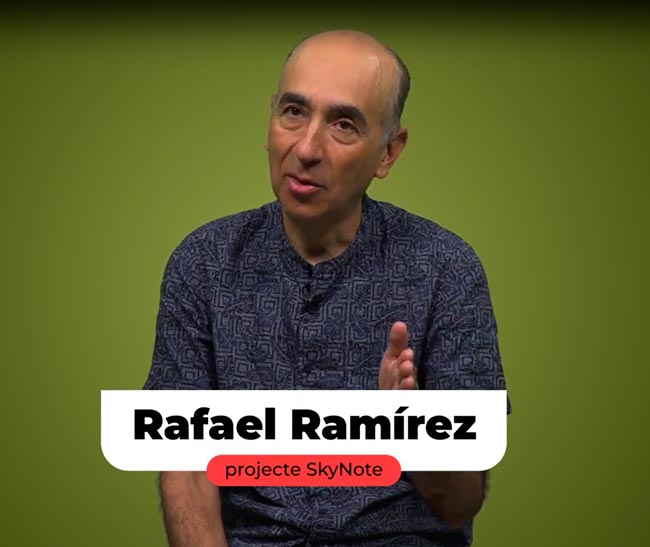Innova
8. Innova
UPF INNOValora: committed to knowledge transfer
The UPF programme to identify and fund research results with the potential to become market solutions
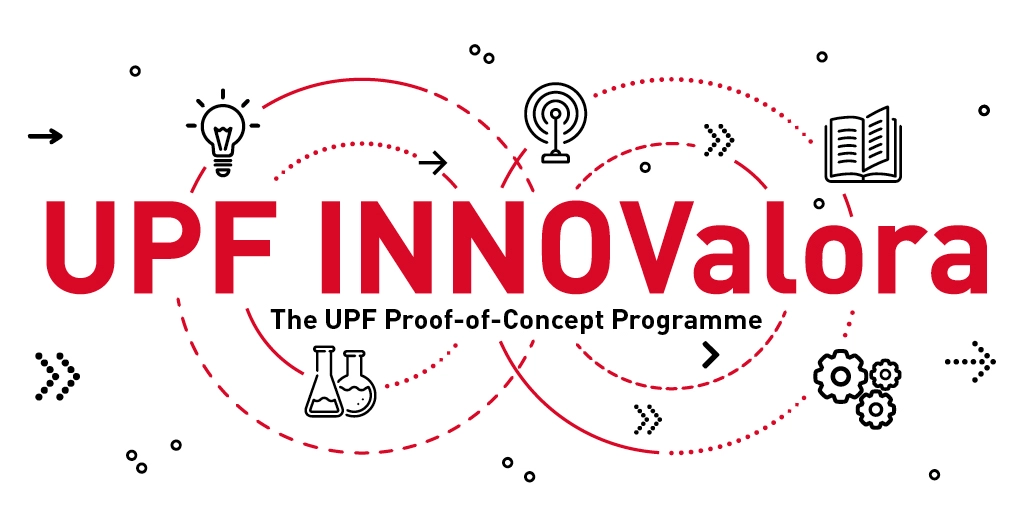
Pompeu Fabra University is strongly committed to its social and economic environment. Accordingly, one of its main missions is to make it easier for the knowledge generated at the university to directly benefit society and the country’s economy. So explained Vanesa Daza, vice-rector for Knowledge Transfer, who considers it essential ‘to link the university to social and economic progress in order to contribute to development and people’s welfare’ and who champions ‘fostering an entrepreneurial culture, increasing the impact of research on society and seeking returns on public investment in research’.
Knowledge and technology transfer from the university to industry is one of the main pillars of Pompeu Fabra University’s 2016-2025 Strategic Plan, specifically, within the area of research. To achieve this mission, the university promotes a variety of transfer activities. One of the most prominent is the UPF INNOValora programme. This initiative, launched in 2018 by the UPF Innovation Unit–UPF Business Shuttle, offers financial support to those UPF research projects with the greatest potential to reach the market so that they can do proofs of concept with the results linked to their research activity, i.e. so they can validate a concept or theory and verify whether it can be consistently applied in a real-life context, exploring its commercial potential. According to Ana Sagardoy, head of the Innovation Unit, ‘The programme’s main objective is to help promising projects based on the research results from the university pursue their development path and reduce the risks, thereby enabling them to attract additional public or private funding to continue their development and, ultimately, reach the market and society.’
Proofs of concept are an essential stage in an innovation process, as they make it possible to further mature research results to ensure that they offer greater guarantees of success in their subsequent stages of development, up to the creation of new products and services able to meet market or societal needs. Hence, the UPF INNOValora programme focuses on this key phase of a project, offering funding for researchers to demonstrate its value, for example, by building prototypes or assessing its commercial potential, and streamlining the transfer process. According to Sagardoy, ‘In this phase of a project, there is a lot of uncertainty: there are a lot of options in terms of the path this promising new innovation should follow and little available funding to resolve questions of applicability or interest. It is necessary to make an effort to transform relevant research results into a project that can be evaluated, developed and implemented as a useful and investment-worthy product or solution.’
It is necessary to make an effort to transform relevant research results into a project that can be evaluated, developed and implemented as a useful and investment-worthy product or solution
The programme funds projects that aim to valorize knowledge or technologies with the potential to be incorporated into the productive sector.’ The proposals have to be based on existing research results owned by UPF (i.e. to which it holds the intellectual and/or industrial property rights), whether solely or jointly with other research bodies that helped to obtain them.
Proposals with a defined practical application concept
UPF INNOValora is intended to support proposals with a Technological Readiness Level (TRL) of at least 3. This international scale was originally designed to estimate the maturity of technologies developed by NASA for aeronautical and aerospace projects. Over the years, it has come to be used more broadly with innovation projects in general, and the European Commission has adopted it as a tool to identify the degree of progress of innovation projects, from ideation to commercial implementation. In other words, the submitted proposals must have met and documented certain basic principles and formulated a technology or commercial application concept that makes them ready to start a proof of concept. For example, proposals based on research ideas or hypotheses that have not yet been explored and for which there is no product or service idea are not sufficiently mature to qualify for a UPF INNOValora grant.
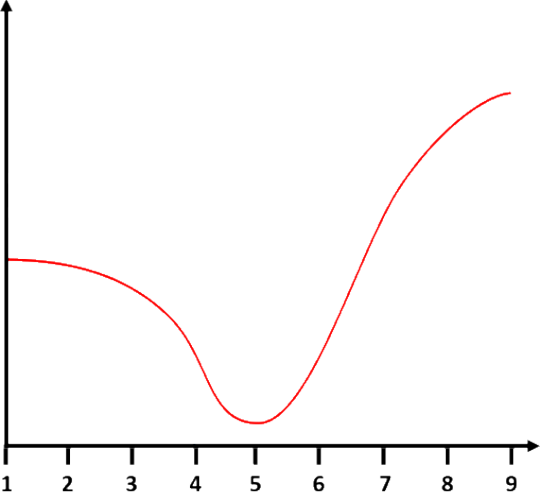
Vertical axis: Financing
Horizontal axis: Technology readiness level
- Basic principles observed and reported
- Technology concept and/or application formulated
- Analytical and experimental critical function and/or characteristic proof-of concept
- Component and/or breadboard validation in laboratory environment
- Component and/or breadboard validation in relevant environment
- System/subsystem model or prototype demonstration in a relevant environment
- System prototype demonstration in a space environment
- System complete and qualified
- Actual system proven in operational environment.
The programme is open to proposals from any UPF research area, i.e. from the health sciences, information and communication sciences, or social sciences and humanities. According to Sagardoy, the goal is ‘to choose the projects that make the most sense in terms of meeting societal needs’. Subsequently, a panel of external evaluators with expertise in different fields remotely evaluates the proposals received and scores them according to each project’s overall quality, degree of innovation, impact and market potential, and entrepreneurial team. This evaluation is used to pre-select the projects that will advance to the final evaluation stage, in which the researchers have to defend their proposals with a brief presentation to the jury, which is made up of the same external experts who evaluated the projects in the first phase.
‘to choose the projects that make the most sense in terms of meeting societal needs
In the last five years, three calls for proposals have been published. Coupled with co-funding from the European Regional Development Fund (ERDF) and the government of Catalonia, they have served to fund a total of 16 projects in the fields of experimental and health sciences and information and communication technology, to the tune of 30,000 euros each. Additionally, since the third edition, the selected projects have been eligible for the UPF Board of Trustees prize, consisting of 5,000 euros for the project to demonstrate the best evolution of its market approach following its passage through the programme. A total of 660,000 euros in funding has been awarded in the programme’s first three editions (including the collaborations of the Department of Medicine and Life Sciences and the UPF Board of Trustees).
Sagardoy also highlighted the participation of mentors in the programme’s execution phase, i.e. professionals with expertise in the target industries of the different participating projects. This additional support was first added in the programme’s third edition ‘so that the mentors could offer the research groups guidance on their project’s next steps or even on how to invest this money’. The mentors can leverage their extensive knowledge of their fields to offer valuable support in terms of business management, legislation, social impact and attracting private funding in their respective sectors. Research teams are generally made up of researchers who are not specialized in these types of projects, so it is important to support them in the definition of their transfer strategy. The mentors are one of the most highly valued aspects of the programme for participants, said Dr Rafael Ramírez, head of the Music and Machine-Learning Lab in the Department of Information and Communication Technologies (DTIC), who participated in the programme with the music-learning technology SkyNote. ‘We were advised by two very capable people, who offered us guidance with regard to market strategies and how to promote our system.’
The mentors can leverage their extensive knowledge of their fields to offer valuable support in terms of business management, legislation, social impact and attracting private funding in their respective sectors
The programme is strengthened with an increased budget
The programme is currently in its fourth edition. This edition is different from previous ones in that it is fully funded by the university itself and has a total budget of 250,000 euros. This budget will make it possible to support five proof-of-concept proposals with an amount of up to 50,000 euros per project for a period of ten months.
Another new feature in the current edition is that the selected projects may allocate part of the funding to contracting staff. Additionally, thanks to the collaboration of the UPF Board of Trustees, a specialized knowledge transfer and entrepreneurship training plan will be offered to all participants.
Five projects evolve into spin-offs
To date, the UPF INNOValora programme has funded the implementation of five projects in the 2018 edition, five in the 2019 edition, six in the 2021 edition and five in the current edition, which corresponds to 2022.
| Applications received | 60 |
| Finalist proposals | 37 |
| Funded proposals | 21 |
| Projects that have ended up being a spinoff | 5 |
| Projects that have followed in acceleration programs | 6 |
As a result of the first three editions, the 16 projects funded by UPF INNOValora have managed to secure additional funding worth almost 2.5 million euros through other public innovation grants, thereby multiplying the initial funding received by a factor of 3.5. Six projects have also been selected to participate in science-based business acceleration or incubation programmes.
Most remarkably, five of the projects that have participated in the programme have been spin off, namely: Lucid Technologies, Integra Therapeutics, KOA Biotech, NoctuRNA Therapeutics, and Disrupt Therapeutics. These companies commercially exploit the research results obtained at the university, and, so far, they have already attracted private investment of more than 6 million euros.
At the same time, other participating projects in the INNOValora programme continue to work actively to make their transfer a reality. One such project is that led by Dr Antoni Ivorra, head of the Biomedical Electronics Research Group (BERG) in the BCN MedTech Research Unit in the DTIC. According to Ivorra, ‘With medical technology, if you want to reach the market, creating a spin-off is key to developing the technology to a point where someone else can start to take it and incorporate it into the industry so it can actually reach patients.’
With medical technology, if you want to reach the market, creating a spin-off is key to developing the technology to a point where someone else can start to take it and incorporate it into the industry so it can actually reach patients
Finally, thanks to the proof of concept carried out with the help of UPF INNOValora, some projects have demonstrated that their value proposition to turn their research into an applied solution was not viable. This is an equally valid outcome, as it allows them to redirect their transfer search and design work towards other alternatives that will allow them to successfully exploit their technology or knowledge.
INNOValora in the first person
Through the testimonials of five researchers who have participated in the UPF INNOValora programme, we discover more details about this initiative and reflect on what transfer means.
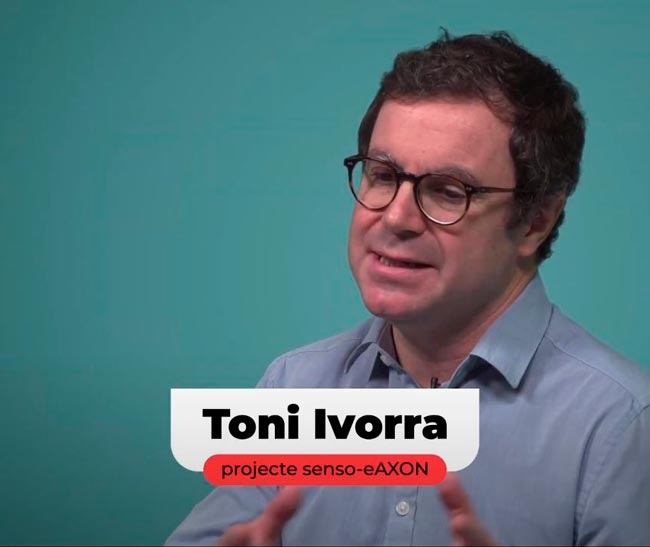
Antoni Ivorra
Head of the Biomedical Electronics Research Group (BERG), in the BCN MedTech Research Unit of the Department of Information and Communication Technologies (DTIC) and TECNIO centre, participated in INNOValora with the project ‘Senso-eAXON’, a proof of concept to develop injectable wireless microsensors based on eAXON technology.
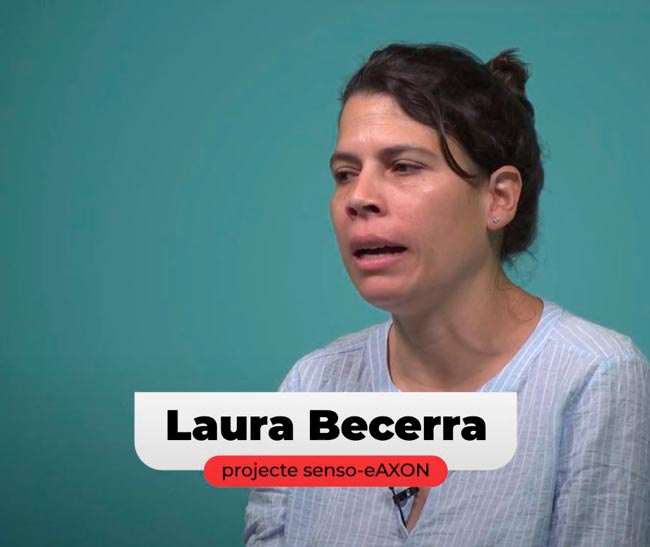
Laura Becerra
Researcher in the Biomedical Electronics Research Group (BERG), in the BCN MedTech Research Unit of the Department of Information and Communication Technology (DTIC) and TECNIO centre, participated in the INNOValora programme with the project ‘Senso-eAXON’.
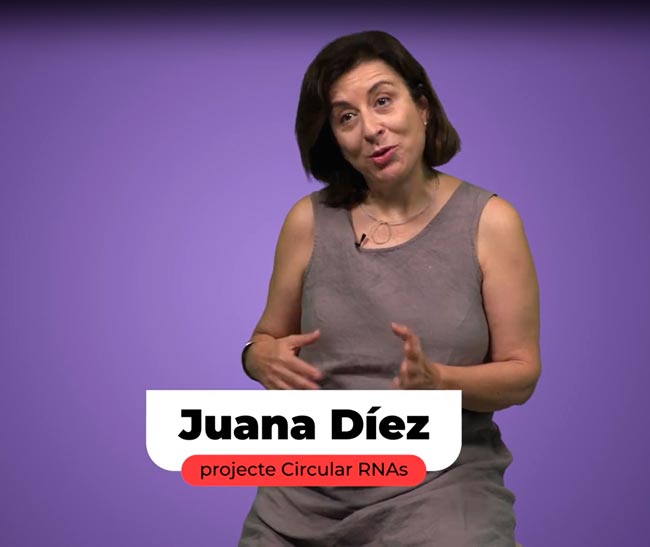
Juana Díez
Principal investigator of the Molecular Virology Research Group, in the Department of Medicine and Life Sciences (MELIS), participated in INNOValora with the project ‘Circular RNAs’, a technology to generate new antiviral molecules to treat numerous infectious diseases caused by RNA viruses.
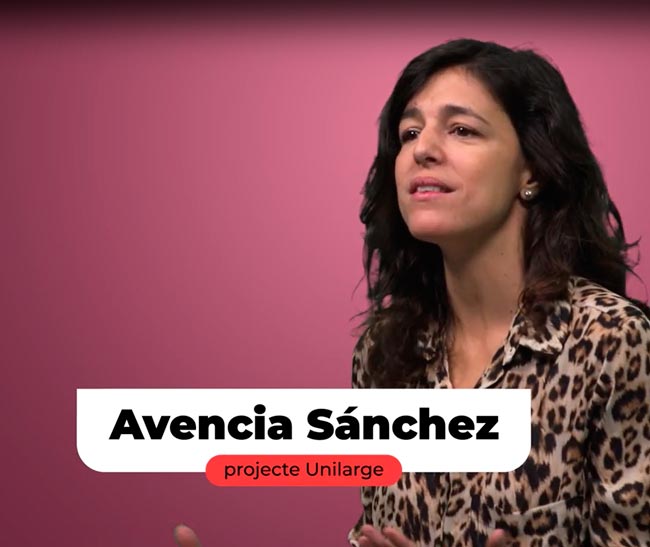
Avencia Sánchez-Mejías
A researcher in the Translational Synthetic Biology Lab (Synbio) in the Department of Medicine and Life Sciences (MELIS) and TECNIO centre, participated in INNOValora with the project ‘Uni-large’, a technology for treating genetic diseases and some cancers arising from gene malfunction. This project was subsequently spun off with the creation of the company Integra Therapeutics, of which Sánchez is a co-founder and CEO.
>> Why did you choose UPF INNOValora?
After participating in the Fundació ”la Caixa” CaixaImpulse acceleration programmes, Dr Sánchez-Mejías’s team clearly saw that the best way to generate value for their solution, the Uni-large technology, was to start a company or spin-off. The UPF INNOValora programme helped them do it. The funding received allowed them to define their idea and business model and hire patent agents to protect their products from the competition.
Dr Ramírez says his group chose UPF INNOValora because they had obtained satisfactory results with the European Telmi (Technology Enhanced Learning of Musical Instrument Performance) project and wanted to develop an intelligent music-learning system for the market but lacked the funding to do so. Their time in the programme allowed them to ‘move from a research prototype to a marketable product’ and they are now considering creating a spin-off. All of this, he says, is in part thanks to the support and advice provided by the mentors, who guided them through the process, since, he explains, ‘We may be computer science and mathematics researchers, but when it comes to business, we have no clue.’
Dr Becerra says her time in INNOValora was motivated by the fact that three members of her team had been co-inventors on a patent application for a new medical device and they wanted to continue developing it. The boost and experience the programme gave them served as a gateway to new funding, which has allowed them to make improvements to the device.
>> What was it like to go from researcher to CEO?
For researchers, getting started in the business world is a real challenge. Running, or helping to run, a business entails a series of responsibilities that many of them are not used to, such as managing a budget, securing investments or defining the operations strategy. It is thus important for them to acquire these leadership and management knowledge and skills.
In this regard, Sánchez-Mejías explains that the day-to-day activities change and a lot of effort has to be dedicated to running the company. Still, she believes her group's journey was a relatively smooth one, thanks to the guidance and support they received from the UPF INNOValora and other acceleration programme mentors. ‘The Barcelona ecosystem is maturing very nicely. There are a lot of people we can turn to when we have questions about managing a biotech company.’
>> What would you recommend doing to move from basic research to applied research with funding?
Basic research is research intended to increase knowledge of a given subject without necessarily having a short- or medium-term application in society. Díez stresses the essential role of this type of research, which she considers the basis of everything. At the same time, however, she believes it is necessary to maintain an applied mindset with regard to the results obtained and ask yourself, ‘How could I turn this into a product that matters for society?’
Sánchez-Mejías underscores the need to always bear in mind that, even if it is basic, the research is publicly funded and that, therefore, it is necessary to constantly assess whether it might have an application. ‘You need to think about how it could offer some sort of a return to society, create jobs, galvanize the economy.’ In this regard, she highlights the role of the UPF Innovation Unit as an agent capable of providing guidance and advice on the feasibility of valorizing knowledge or a technology.
In short, Sánchez-Mejías believes that a new mindset is needed and that, in parallel with the research processes, the results should be analysed in terms of their application, ‘how to protect what you are inventing so that it will be economically viable in the future’.
>> Why is it important to promote knowledge transfer?
For Ivorra, the main motivation is to incorporate the technology into industry so that it reaches the target public, namely, patients. ‘Although we often do research that can be considered basic, ultimately, we are always thinking about the application.’
Díez notes that starting to think about transfer was a very big change for her. ‘It is not an area that researchers are used to’, she says, saying that she believes that the support received from the UPF INNOValora programme giving them that initial boost was fundamental. She also highly values having teamed up with a business manager, who is responsible, amongst other things, for seeking funding, ‘because it is not the same to present to researchers – who care about the science – as to investors – who care not only about the science, which has to be sound, but also the market study, how it differs from other products, why they should invest, etc.’.
For Ramírez, transfer is also essential for research work to have an impact on society. Additionally, he says, it has allowed him to discover the world of entrepreneurship, a very interesting field that forces you to rethink your project with key tasks such as defining your positioning strategy.
>> Would you recommend participating in UPF INNOValora?
All four project teams rate their experience with INNOValora very highly. For Becerra, transfer is part of researchers’ role, meaning all researchers should promote it in order to have an economic impact and social benefit. In her case, she says, ‘The programme gave us the impetus we needed to continue the project.’ It allowed them to conduct the first preclincial tests, apply for a patent and do a market study.
Díez advises, ‘If you have a result that you think could reach the market, don’t assume that it is too difficult or impossible; go to INNOValora.’
Finally, Ramírez underscores the value of the constant follow-up from the programme’s management team. ‘Not only do they offer money, they advise you on how to use it in a more market-driven way.’

